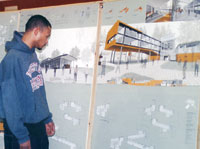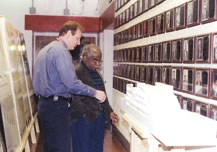 |
Perth Amboy may be a typical old-line industrial town in New Jersey, but town officials are hardly using a traditional approach to build a new $100-million high school. Eager to move away from the status quo in school architecture, they have launched a design competition that has already brought in top names to the pool of competitors and jurors. While some question the economics of such a complex process for a school, organizers hope it will jump-start a needed urban revitalization in 286-year-old Perth Amboy, New Jerseys first incorporated city.
Although the existing Perth Amboy High School building is less than 35 years old, it is bursting at the seams. Originally built for 1,600 students, it now has 2,100, with more to come as the citys heavily Latino population grows. In 2001, officials decided it was time to build a new school that could hold 3,000 pupils.
|
That drew the attention of the state, which was forming a new statewide school construction organization on the heels of a recently approved $9-billion school bond. Perth Amboy is one of a number of low-income urban school districts in the state that qualify for 100% funding.
School officials were concerned that existing state procurement practices would not accommodate out-of-the-box design ideas they needed for such a large project, so the design competition idea was born. "We were afraid that if the state started building schools by the ton, they would be cookie cutter," says Austin Gumbs, school board president and a lifelong city resident. "The city is undergoing massive rejuvenation. Schools are part of that."
A $50,000 federal grant fed Perth Amboys competition process, which grew to $247,000 with additional state and private funds, says Ellen Shoshkes, competition director. The competition attracted much attention, drawing some 200 registered inquiries and official proposals from 136 firms or teams. "We had designs from all over the country, and from Argentina and Spain," says high school Principal Rosalia Czaban. "That included top-notch architects."
 |
| CLOSE-UP Perth Amboy high school student reviews building designs on display in school lobby. |
The competition challenge is centered on the districts desire to build "schools within a school" at the new high school, officials say. The approach is meant to allow more targeted focus on smaller groups of students. Design would accommodate several career-themed "academies" such as health, marine sciences, public safety and communications technology. "No one in their right mind would build a 3,000-person school," says Shoshkes. "The idea is break it down to focus on the themes and relate this to realistic career paths." That includes careers geared to students who may not be college-bound, says Czaban.
Another challenge is creating a design to accommodate a 677,000-sq-ft structure on a 15-acre site the school district obtained in a municipal land swap. More desirable waterfront sites were either too polluted or already taken for private development, so the district set its sights on an occupied city housing property. The municipal housing authority will relocate residents to a new 200-unit complex, says Shoshkes.
Competition officials have now whittled down contenders to a final group of four whose designs were publicly revealed Jan. 23 in the high schools front lobby. That task was accomplished by the competition jury that includes architect luminaries such as Henry Cobb, principal of Pei Cobb Fried and Partners, New York City, and Toshiko Mori, chair of Harvard Universitys Dept. of Architecture. Gumbs, Perth Amboy Mayor Joseph Vas and New Jersey Education Dept.s facilities chief Bernard Piaia balance the architects.
Making the cut hasnt been easy for the contenders, most of whom were not "prequalified" with the state School Construction Corp. The four finalists are: Fox & Fowle Architects, New York City; Morphosis, Santa Monica, Calif.; John Ronan Architect, Chicago; and Eisenman Architects, also New York City. Only Fox & Fowle was prequalified by the state to handle a $100-million project, says Peter McGlinchy, SCC director of special projects. Eisenman recently replaced another finalist that was forced to withdraw when it could not satisfy state qualifications, says Shoshkes. It and the other contenders are forming larger joint venture teams to meet state rules. But competition officials declined to reveal the names of team member firms.
The finalists have submitted technical and price proposals to SCC, which will then brief jurors before a final selection is made. That date is now set for Feb. 24, says Shoshkes. That decision will also include additional community input on the new designs, including from students. Czaban was surprised at the level of student interest, she says. "Some seniors wished they were staying around to be part of it," she adds. The school is set for construction completion in 2007.
 |
| PAST AND FUTURE School board president and juror Gumbs (right) discusses one design model with an associate. A finalist will be selected next month, in a competition that drew 150 proposals. |
Each of the four finalists received $20,000 in honoraria to cover their design efforts, but the amount doesnt quite cover their competition costs. "There are a lot of hoops you have to jump through while youre trying to design at the same time," says architect John Ronan. "Were only 10 people." He says the cost is outweighed by the opportunity for his five-year-old firm to compete in such a high-profile effort. "This one was particularly challenging, but its beneficial for my artistic development," says Ronan.
New Jersey is also using a design competition to expand and renovate a 100,000-sq-ft elementary school in Trenton, says Shoshkes. Perth Amboy officials are pleased with the experience and believe the competition should be used elsewhere in the state. SCCs McGlinchy wont say if the approach will continue. The state will first be reviewing the existing competitions. "The cost-effectiveness has to be weighed," he says.
Still, Perth Amboy officials couldnt be happier with the process and what theyll get in the end. "As an inner city, we want to give our students a good reason to stay in school," says Gumbs.
(Photos by Debra K. Rubin)
![]() Click below to view more articles related to this story >>
Click below to view more articles related to this story >>
Museum, District Collaborate To Build An Unusual Hybrid
To Help Save Time, Structural Engineer Wears Harder Hat
Demographics Drive Market: Kids Keep School Work Going Strong

Post a comment to this article
Report Abusive Comment